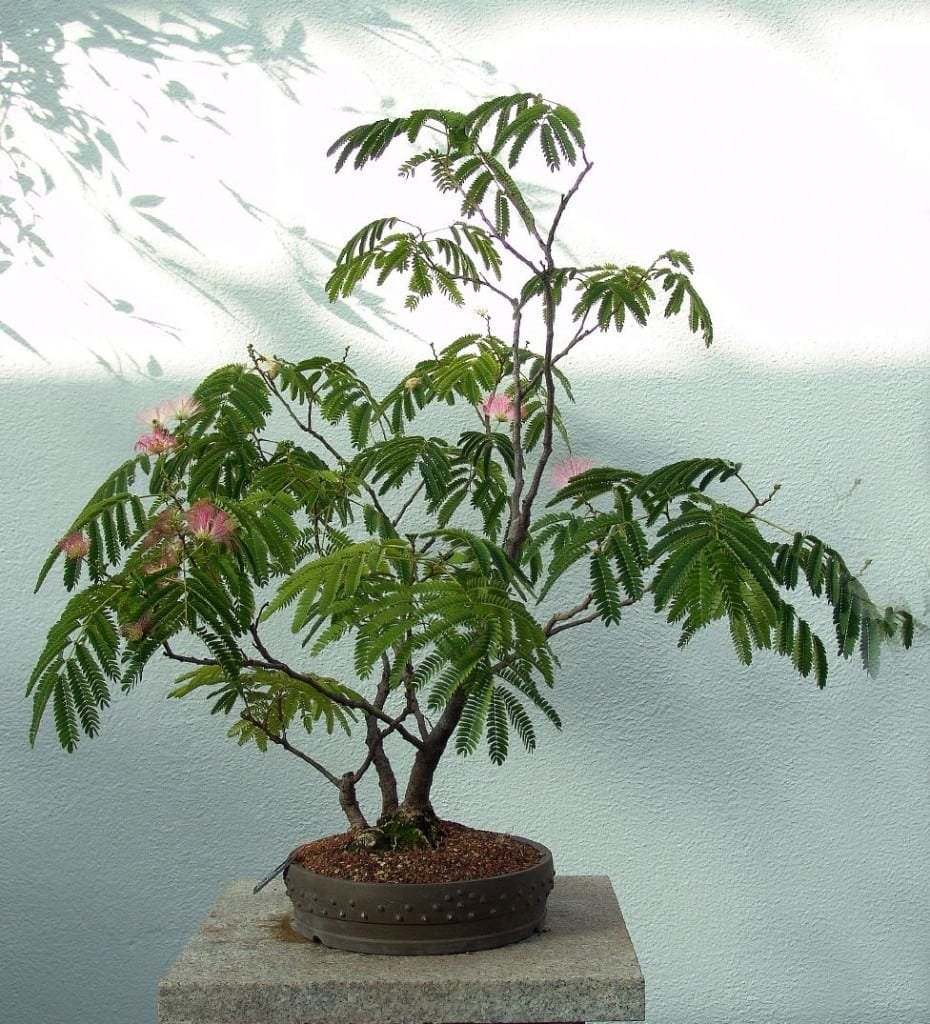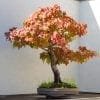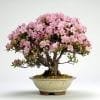The exquisite rosy colored pom-poms that mimosa trees, Albizia julibrissin, produce are one of the reasons they are such a popular bonsai tree. Other ways these mimosa plants seem made for this art form include the delicate and fern like fronds covered in miniature leaves.
These unique characteristics lend a particularly elegant and delicate feel to bonsai living sculptures. Mimosa trees also make great bonsai plants because they grow quickly. This means that the trunk and limbs of the plant thicken faster than other types of bonsai plants and sculpting them is thus easier.
The fragrant flowers of a mimosa bonsai are what make it such a unique and beautiful plant. Blooming in summer, these flowers actually have no petals but instead delicate, silky clusters of white and pink stamens, the part of a flower that is usually centered among and smaller than the petals.
This unique bloom gives this plant the nickname “silk tree” and even attracts butterflies, bees, hummingbirds and other garden pollinators when grown outside.
One of the most unique characteristics of a mimosa bonsai is that each leaf on each branch folds and closes every evening or, if outside, during rainfall. This is a natural trait in Albizia julibrissin and is probably the most known fact about this plant.
It was brought to Europe from the east during the 1780s by an Italian nobleman. As tall, wispy trees, mimosa trees have been popular as shades trees along the coasts of the United States since they were first imported over a hundred years ago. Only later was it discovered to also be an excellent bonsai tree.
| Scientific/Botanical Name | Albizia julibrissin |
| Description | Mimosa trees are indigenous to China, but they have been cultivated in coastal and southern regions of the U.S. since the late 1700s. They are prized as shade trees. Mimosas grow rapidly. They exhibit distinct fern-like foliage and fragrant, eye-catching flowers. Mimosa trees are relatively short-lived, very rarely surviving beyond 20 years. |
| Position | Mimosa trees are intolerant of cold climates. The ideal USDA planting zones are between 6 and 10. The trees require protection when the temperature falls below 60o Fahrenheit so as to minimize the risk of die-back. Mimosas should be planted in full sun, and the trees cannot be grown indoors. |
| Watering | Mimosa trees are tolerant of drought. Allow the soil to become nearly dry before giving water to the plant, and avoid getting water on the flowers when in bloom. |
| Feeding | There is no information available on feeding. |
| Leaf and Branch Pruning | Pruning should be undertaken every spring, and because mimosa trees are fast growers, they are tolerant of severe pruning. |
| Re-potting & Growing Medium | Mimosa trees are generally grown in-ground, and they are tolerant of a wide range of soils. |
| Wiring | The trees have extremely soft bark and easily-broken branches. As such, they do present certain problems when wiring. Only new growth should be wired, and it is important to use small-gauge wires. Wires should only be left on for about two weeks because new growths develop at a rapid pace. |
| Notes | Mimosas display a particularly fascinating characteristic: Stimulated by a lack of light, their foliage take on a folded and closed appearance during the night. |
A Rose By Any Other Name…
The tree that is most often used in mimosa bonsai has the Latin name Albizia julibrissin. It is native to China and, over the years, has developed more than one common name making it hard to know what variety of tree is truly being discussed.
Albizia julibrissin is most often referred to as the silk tree, but this title does not specify the species julibrissin only the fenus Albizia. In fact, any species of Albizia is considered a silk tree though only juibrissin is used for bonsai.
Other names for Albizia julibrissin include mimosa, Lenkoran acacia and bastard tamarind even though the plant has no connection to the actual mimosa, acacia or tamarind families of plants. To make matters worse, mimosa is also used for several other genera equally unrelated to the actual mimosa plant.
In bonsai circles, Albizia julibrissin is commonly called mimosa. Though outside this niche the title may relate to many other plants, in the context of bonsai mimosa means specifically Albizia julibrissin.
To further clarify, Albizia julibrissin is never referred to as tropical mimosa as this plant is also used for bonsai but is in actuality a true mimosa.
In the wild, Albizia julibrissin can grow to be forty feet tall and is characterized by a broad crown of leaves. The leaves are small, oblong and arranged in groups of six to twelve on either side of thin, flexible pinnae.
These delicate fronds measure over a foot in length and eight inches across on adult trees. Each tiny leaflet measures about an inch and a half in length and less than one-seventh of an inch across. The bark tends to be dark green or gray and develops vertical stripes as it ages.
Cultivating A Mimosa Bonsai
The ideal environment to grow a mimosa bonsai requires a temperature of over 60 degrees at all times. Native to China, mimosa trees like a relatively dry climate and sunlight is a must. This makes them hard to grow in most climates but also means they are drought resistant. Rather than dryness, it is cold and wet weather that present the biggest problem to mimosa trees.
Be careful of watering the mimosa bonsai as too much will drown the plant and too little will cause it to wilt. Damp roots are the leading cause of illness among bonsai plants. It is key to have an excellent drainage system for whatever the bonsai is planted in.
When in bloom, avoid getting the flowers wet as this can make them fall off the plant sooner. On the flip side, a bonsai mimosa can become quite dry without suffering long-term side effects.
Unlike some other plants used for bonsai, mimosa trees need full sunlight all day long so growing this plant inside is nearly impossible. Luckily, mimosa trees aren’t picky at all about what kind of soil they grow in.
There are certainly soil ingredients that can be added to make the tree grow even better, but in general a mimosa will survive regardless of the sandiness, acidity or otherwise unappealing nature of the soil.
Because of the notably large size of mimosa trees, these plants are sometimes not considered traditional bonsai. Their large size also makes them best suited for outdoor living if the climate allows.
Shaping A Mimosa Bonsai
The fast growing characteristic of mimosa trees make sculpting them into bonsai less tedious than it is with other types of plants. This can definitely appeal to beginners in particular.
However, the sculpting process with a mimosa requires an intermediate bonsai skill level so beginners beware. Mimosa is certainly not the easiest bonsai plant to shape but it is not the hardest, either.
Another benefit of a mimosa for bonsai is that this plant can withstand a harsh pruning each spring. This not only helps sculpt the plant more precisely, it also speeds up the process. For those interested in bonsai but not overly concerned with specific shaping details, a mimosa bonsai is a great choice.
One downside of the mimosa bonsai is that it is relatively short lived. While some bonsai plants can survive happily for decades, mimosa trees rarely live to be 20.
Using a mimosa tree for bonsai is best done outdoors in a climate that will foster the plant. Remember to move the plant inside if the weather threatens to go below 60 degrees and not to over water. The styling options and techniques possible are varied as this is particularly large bonsai plant and grows quickly.


